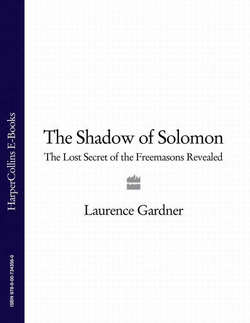Читать книгу The Shadow of Solomon: The Lost Secret of the Freemasons Revealed - Laurence Gardner - Страница 20
A Royal Charter
ОглавлениеIn time, and specifically from 1660, the Rosicrucian aims of the group emerged into the open with the Restoration of the flamboyant King Charles II. Quite suddenly, and irrespective of clerical opinion, they gained approval and recognition by way of a Stuart charter in 1662, to become known henceforth as the Royal Society. Their motto was established as Nullis in verba, which translates roughly to ‘Take no one’s word for it’—a motto which had been used previously by Sir Francis Bacon.
The Society’s new status was achieved by two influential members, namely the Scottish statesman Sir Robert Moray and the Gresham College president William, Viscount Brouncker—both of whom had direct access to the king. In the event, it was Moray who approached King Charles on behalf of the fraternity, securing his patronage and encouragement. Having been Attaché to Cardinal Richelieu in France during the Protectorate, Moray was a man of enormous influence in court and government circles, and was greatly respected by the royal household. By that time, other subsequently famous characters, such as Elias Ashmole and the diarist John Evelyn, had joined the group. Viscount Brouncker (though not a scientist) became the Society’s first President, with Robert Hooke appointed as the first Curator and, on 20 May 1663, some 150 Fellows were elected from the fastgrowing overall membership.
The House of Stuart progenitor, Robert the Bruce had inaugurated the Elder Brethren of the Rosy Cross in 1317—a Knight Templar institution13 which was inherited 11 generations later by King Charles II. It is no coincidence that the first two known prominent masonic initiates in England, Sir Robert Moray and Elias Ashmole, were both foundation Fellows of the Royal Society and members of the Rosicrucian movement. The Royal Society’s New Philosophy (as Wren had dubbed it) was therefore largely Rosicrucian and, as such, was immediately concerned with matters of hermetic alchemy.
King Charles’s paternal aunt, Princess Elizabeth—the daughter of King James I (VI)—had married Frederick V, Elector Palatine, in 1613. Hence, it comes as no surprise that the House of Stuart, with its link to the Bohemian Palatinate, accompanied by John Wilkins’ own Rosicrucian chaplainship, was eager to acknowledge the enthusiastic brotherhood of the Royal Society. In so doing, King Charles effectively reconstituted the Brethren of the Rosy Cross, taking on the Grand Mastership of his family’s traditional Order.
To leave no doubt in anyone’s mind that the Royal Society was a Rosicrucian establishment, the Society’s historian Thomas Sprat included a descriptive frontispiece illustration in his 1667 History of the Royal Society (see plate 12). Designed by John Evelyn and engraved by Wenceslas Hollar, the Society’s inaugural picture depicts a bust of King Charles, along with Viscount Brouncker and Sir Francis Bacon who had died many years before in 1626. Also featured in the engraving is the trumpet-bearing Angel of Fame from the Fama Fraternitatis of the 1614 Rosicrucian Manifestos, along with a number of books and masonic devices.14
Having moved to join their colleague Christopher Wren at Gresham College, the founding Fellows soon became a threat to all sectors of the establishment, whether governmental, educational or clerical. But, despite this, they appeared like a breath of fresh air to the people at large—and best of all, they had the popular King Charles as their patron, with his personal access to the masonic archive of the Kings of Scots.
